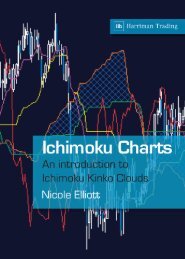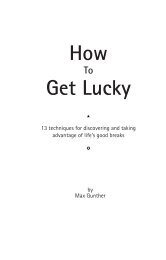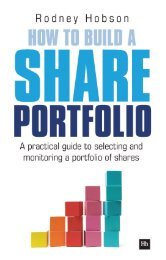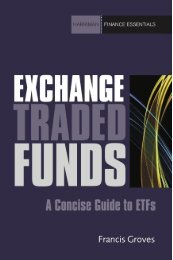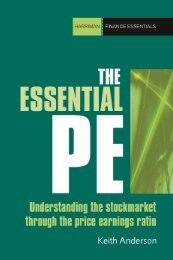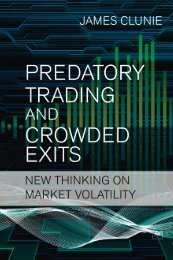The Financial Spread Betting Handbook - Harriman House
The Financial Spread Betting Handbook - Harriman House
The Financial Spread Betting Handbook - Harriman House
You also want an ePaper? Increase the reach of your titles
YUMPU automatically turns print PDFs into web optimized ePapers that Google loves.
• • • • Sample • • • •<br />
www.harriman-house.com/financialspreadbettinghandbook
<strong>The</strong> <strong>Financial</strong> <strong>Spread</strong> <strong>Betting</strong><br />
<strong>Handbook</strong><br />
<strong>The</strong> definitive guide to making money<br />
trading spread bets<br />
by Malcolm Pryor
HARRIMAN HOUSE LTD<br />
3A Penns Road<br />
Petersfield<br />
Hampshire<br />
GU32 2EW<br />
GREAT BRITAIN<br />
Tel: +44 (0)1730 233870<br />
Fax: +44 (0)1730 233880<br />
Email: enquiries@harriman-house.com<br />
Website: www.harriman-house.com<br />
First edition published in Great Britain in 2007 by <strong>Harriman</strong> <strong>House</strong>.<br />
This second edition published 2011.<br />
Copyright © <strong>Harriman</strong> <strong>House</strong> Ltd<br />
<strong>The</strong> right of Malcolm Pryor to be identified as the author has been asserted<br />
in accordance with the Copyright, Design and Patents Act 1988.<br />
978-0-857190-85-7<br />
British Library Cataloguing in Publication Data<br />
A CIP catalogue record for this book can be obtained from the British Library.<br />
All rights reserved; no part of this publication may be reproduced, stored in a retrieval system, or<br />
transmitted in any form or by any means, electronic, mechanical, photocopying, recording, or<br />
otherwise without the prior written permission of the Publisher. This book may not be lent, resold,<br />
hired out or otherwise disposed of by way of trade in any form of binding or cover other than<br />
that in which it is published without the prior written consent of the Publisher.<br />
Printed and bound in Great Britain by CPI Antony Rowe, Chippenham<br />
No responsibility for loss occasioned to any person or corporate body acting or refraining to act<br />
as a result of reading material in this book can be accepted by the Publisher, by the Author, or by<br />
the employer of the Author.<br />
Designated trademarks and brands are the property of their respective owners.
For Karen
Contents<br />
Preface to the 2011 edition<br />
Preface<br />
Acknowledgements<br />
Risk Warning<br />
Introduction<br />
xi<br />
xv<br />
xviii<br />
xix<br />
xxi<br />
PART 1 – Base Camp 1<br />
1. Choosing A <strong>Spread</strong> <strong>Betting</strong> Firm 5<br />
Origins and growth of the market 7<br />
Selection criteria 8<br />
<strong>The</strong> 6-Stage Plan for opening an account 9<br />
2. Getting Set Up – Computer Hardware And Software 11<br />
Hardware 13<br />
Internet connection 15<br />
General software 15<br />
Backing up 16<br />
3. Trading Resources 17<br />
Trading software 19<br />
Price data 21<br />
Information 24<br />
Websites 25<br />
4. What Do Winning <strong>Spread</strong> Bettors Bet On? 27<br />
Markets 29<br />
<strong>The</strong> 3 key tests 32<br />
Differences between the spread betting firms 37<br />
Personal observation 37<br />
5. Choosing A <strong>Spread</strong> <strong>Betting</strong> Type 39<br />
Types of betting 41<br />
Differences between the spread betting firms 47<br />
6. Timescales For <strong>Spread</strong> Bets 49<br />
1. Extremely short timescale 51<br />
2. Short timescale 51<br />
3. Medium timescale 52<br />
4. Long timescale 52<br />
5. Very long timescale 54<br />
v
<strong>The</strong> <strong>Financial</strong> <strong>Spread</strong> <strong>Betting</strong> <strong>Handbook</strong><br />
7. Pricing And Hedging 57<br />
Do they really want you to win? 59<br />
How spread betting firms work out their prices 61<br />
How competitive is the market? 64<br />
Do they hedge? 64<br />
Future developments – a wish list 65<br />
8. 10 Common And Really Expensive <strong>Spread</strong> <strong>Betting</strong> Errors 67<br />
1. No edge 69<br />
2. No planning 69<br />
3. Wrong bet size 70<br />
4. No risk management 71<br />
5. Mistiming exits 72<br />
6. Out of control 74<br />
7. Not in tune with the markets 75<br />
8. Running before walking 76<br />
9. Emotionally unstable 76<br />
10. Not taking responsibility 77<br />
9. Keeping Losses Small – <strong>The</strong> Stop Loss 79<br />
Stop or no stop? 81<br />
Near or far? 82<br />
Automated or mental? 83<br />
Instant or delayed? 84<br />
Techniques for placing stops 84<br />
One more useful approach – the time stop 87<br />
Two tips 87<br />
Moving stops 88<br />
10. <strong>Spread</strong> <strong>Betting</strong> Order Types 91<br />
Time stop 97<br />
Are some orders better than others? 98<br />
What’s on offer in the market? 100<br />
11. Practical Issues 101<br />
Order placement 103<br />
Automated stop orders 107<br />
Dispute resolution 109<br />
Funds transfers 111<br />
Keep abreast of your margining position 111<br />
Congratulations! 112<br />
vi
Contents<br />
PART 2 – Climbing <strong>The</strong> Mountain 113<br />
12. Finding A Strategy That Works For You 117<br />
What do you like? 119<br />
Technical analysis is excellent for spread betting 120<br />
<strong>The</strong> basic choice: trend or countertrend strategies? 123<br />
Or delta neutral strategies 125<br />
Master one strategy first 125<br />
13. <strong>Spread</strong> <strong>Betting</strong> Strategy I – <strong>Betting</strong> On A Trend –<br />
Trend Identification 127<br />
Basic concept – using spread betting to ride a trend 129<br />
Break outs or pullbacks? 132<br />
How to identify trends 132<br />
14. <strong>Spread</strong> <strong>Betting</strong> Strategy I – <strong>Betting</strong> On A Trend –<br />
Selecting A Bet 147<br />
Simplifying trade selection – the weekly shortlist 150<br />
Simplifying trade selection – identifying daily set ups 152<br />
Taking the trade – entry triggers 155<br />
A new approach to short listing 157<br />
15. <strong>Spread</strong> <strong>Betting</strong> Strategy I – <strong>Betting</strong> On A Trend – Bet Size 159<br />
Taking the trade – the right size of spread bet 161<br />
16. When To Exit A Bet 167<br />
1. <strong>The</strong> bet goes against us 169<br />
2. <strong>The</strong> bet goes nowhere 169<br />
3. <strong>The</strong> reason for the bet disappears 170<br />
4. <strong>The</strong> bet goes our way 170<br />
17. <strong>The</strong> Re-entry 177<br />
18. <strong>Spread</strong> <strong>Betting</strong> Strategy II – <strong>Betting</strong> On Reversals 181<br />
1. Buying support and selling resistance 183<br />
2. <strong>Betting</strong> on candle patterns 185<br />
3. <strong>Betting</strong> on gaps 187<br />
4. <strong>Betting</strong> on divergence 187<br />
19. <strong>Spread</strong> <strong>Betting</strong> Strategy III – In And Out Within A Day 191<br />
You need the time to do this 193<br />
Finding intraday bets 193<br />
<strong>Betting</strong> as company results come out 193<br />
<strong>Betting</strong> on false break outs 195<br />
<strong>Betting</strong> on blow offs 198<br />
<strong>Betting</strong> on indices and currencies intraday 199<br />
Binary betting 202<br />
vii
<strong>The</strong> <strong>Financial</strong> <strong>Spread</strong> <strong>Betting</strong> <strong>Handbook</strong><br />
20. Advanced Strategies 207<br />
Arbitrage 209<br />
Pairs trading 211<br />
Hedging 215<br />
PART 3 – <strong>The</strong> Route To <strong>The</strong> Summit 217<br />
21. <strong>The</strong> Right Strategy For You 221<br />
Character 223<br />
Account size 224<br />
Beliefs 224<br />
Attitude to risk 226<br />
22. Staying In Control – Planning 229<br />
Annual trading plan 231<br />
A week in the life of a successful spread bettor 233<br />
23. Staying In Control – Record Keeping 237<br />
24. Staying In Control – Regular Reviews 241<br />
Monthly review 243<br />
Annual review 244<br />
25. Staying In Control – Risk Management, Again 245<br />
Staying in tune with the markets 247<br />
Monitoring positions 248<br />
Margin control 249<br />
Managing total exposure and leverage 249<br />
Net long/short 251<br />
Diversification 251<br />
Standing aside 251<br />
Counterparty risk 252<br />
Exceptional events 252<br />
Contingency planning 252<br />
26. Developing A Winning Attitude 255<br />
Profile of the successful spread bettor 258<br />
10 rules for profitable spread betting 260<br />
27. Continual Development 263<br />
Books 265<br />
Seminars 267<br />
viii
Contents<br />
Appendices 269<br />
Examples of Basic Bets 271<br />
<strong>Spread</strong> <strong>Betting</strong> Glossary 273<br />
ADX 275<br />
Support and Resistance 276<br />
<strong>Betting</strong> via Exchanges 277<br />
How it works 277<br />
Benefits and risks of this type of betting 277<br />
Index 279<br />
ix
Preface to the 2011 Edition<br />
Major changes in the spread betting arena<br />
It is four years since the first edition of this book was published and there<br />
have been some major changes in the spread betting arena.<br />
Here are some of them:<br />
1. <strong>The</strong> number of firms offering spread betting services has increased<br />
significantly to well over 50, partly due to the proliferation of white label<br />
services where an established firm licenses its technology to another firm<br />
which then repackages the services under their own brand name.<br />
2. <strong>The</strong> customer base has become more sophisticated, being much more<br />
ready to jump ship to another firm if they see tighter spreads or better<br />
products.<br />
3. <strong>The</strong>re has been downward pressure on the size of spreads. A decade ago<br />
I had to pay a spread of 12 on the FTSE making day trading impractical,<br />
now the spread is 1; on two of the currencies I trade I can get a spread of<br />
zero (and the spread betting firm still makes money).<br />
4. Some unacceptable practices, such as the infamous requoting of prices,<br />
have been discontinued.<br />
5. Trading platforms have improved considerably, including the quality of<br />
real time technical analysis tools.<br />
6. Many firms have invested heavily in education, in particular making<br />
significant improvements to the quality of their websites.<br />
Despite all of this the vast majority of spread bettors are still not winning on<br />
a regular basis and the original purpose of this book which was to identify<br />
what winners do that losers don’t, and vice versa, remains as valid as it was<br />
four years ago.<br />
For instance, in the first edition of the book I remarked that most share<br />
traders remained long throughout the 2002 bear market, to their cost.<br />
Since then we have seen the credit crunch, and another bear market, and once<br />
again that bias for going long (rather than adapting to the market conditions<br />
and looking to go short) has cost spread bettors dearly.<br />
xi
<strong>The</strong> <strong>Financial</strong> <strong>Spread</strong> <strong>Betting</strong> <strong>Handbook</strong><br />
Key changes in the 2011 Edition<br />
<strong>The</strong>re are quite a few changes in this second edition, partly due to the changes<br />
in the spread betting world discussed above, and partly due to new<br />
developments in my own trading. Here is a brief list of some of the key<br />
changes.<br />
Changes in Part One<br />
• Sections on computer hardware updated to reflect recent developments in<br />
technology<br />
• Sections on price data updated to reflect improvements in the quality of<br />
data supplied by the spread betting firms<br />
• www.spreadbettingcentral.co.uk introduced, you are strongly<br />
recommended to join the forum at this site<br />
• Updated information on spreads, and updated tables reflecting the<br />
changed spread betting and market environment<br />
• Updated information on cost of carry<br />
• Revised analysis of spread betting firms’ approach to pricing and hedging<br />
• Updated wish list for future improvements in spread betting firm<br />
products<br />
• An additional trailing stop technique<br />
• Updated analysis of available order types<br />
• Substantially revised section on practical issues reflecting the changes in<br />
spread betting firm practices<br />
Changes in Part Two<br />
• More explicit introduction to Part Two, emphasizing that the strategies<br />
are there to demonstrate the wide range of strategies available to spread<br />
bettors, and that they are illustrative, not designed to be followed<br />
verbatim<br />
• Illustration of an additional technique for defining a trend (many readers<br />
of the first edition zoomed in on ADX, perhaps looking for a “silver<br />
xii
Preface to the 2011 Edition<br />
bullet” to solve all their trading problems; in my own trading I use ADX<br />
a lot less than I used to)<br />
• Section on divergence plays rewritten<br />
• Expanded and amended section on intraday strategies, reflecting changes<br />
in my own preferences<br />
Changes in Part Three<br />
• Updated sections on record keeping and on regular reviews<br />
• Completely rewritten section on managing total exposure and leverage<br />
(the concept of portfolio heat is introduced)<br />
• Updated list of my top 25 books, including some published after the first<br />
edition of my book was published<br />
Changes in the Appendices<br />
<strong>The</strong> list of spread betting firms is no longer included (go to<br />
www.spreadbettingcentral.co.uk for latest list).<br />
<strong>The</strong> song remains the same<br />
<strong>Spread</strong> betting continues to attract new entrants both in terms of new firms<br />
supplying spread betting services and new customers. <strong>Spread</strong> betting products<br />
have been improved further over the last few years. Provided that using these<br />
products is consistent with their objectives and risk preferences traders and<br />
investors have the opportunity to take advantage of price movements on<br />
different timeframes and across a range of instruments. <strong>The</strong> benefits are as<br />
clear now as they were four years ago, However, so are the risks if those<br />
traders and investors fail to prepare themselves adequately to “climb the<br />
mountain”. That is still what this book is about.<br />
xiii
Preface<br />
About the author<br />
Malcolm Pryor is a member of the Society of Technical Analysts in the UK<br />
and has been designated a Certified <strong>Financial</strong> Technician by the International<br />
Federation of Technical Analysts.<br />
He is a director of a consultancy practice, and is an expert at several games,<br />
including bridge where he has held the rank of Grandmaster or higher since<br />
1996.<br />
What this book covers<br />
This is a book about financial spread betting. Although spread betting started<br />
way back in the 1970s, recent years have seen an explosion of interest, with<br />
increased demand for the product and new betting firms entering the<br />
marketplace. It is easy to open an account, and many people now have done<br />
so. Unfortunately, it is not so easy to make money.<br />
What do successful spread bettors do that is different?<br />
This book has been written to try to answer that question.<br />
Who this book is for<br />
This book is not for:<br />
• complete beginners, it assumes a basic understanding of how spread<br />
betting works;<br />
• people who think there is easy money out there, just waiting to be picked<br />
up;<br />
• those who want to spread bet for the adrenalin rush, irrespective of the<br />
results.<br />
Rather, the book has been written for people who want to have a serious go<br />
at spread betting, managing costs and risks, and who recognise that it will<br />
take some skill and effort.<br />
xv
<strong>The</strong> <strong>Financial</strong> <strong>Spread</strong> <strong>Betting</strong> <strong>Handbook</strong><br />
If you are one of those people, this book will be of interest to you whether<br />
you have a spread betting account now, had one in the past, or are thinking<br />
of getting one in the future.<br />
<strong>The</strong>se days, the vast majority of spread bets are placed online. I am assuming<br />
that readers will already have a computer or laptop with internet<br />
connectivity.<br />
How this book is structured<br />
Imagine a mountain called <strong>Spread</strong> <strong>Betting</strong>. Our mission is to climb it.<br />
<strong>The</strong>re are three key stages to climbing a mountain:<br />
1. first a Base Camp must be established;<br />
2. from there the journey up the mountain face begins; and<br />
3. finally one makes an attempt on the summit.<br />
This book reflects this three stage approach and is divided into three main<br />
parts. Let’s expand on this a little.<br />
We start with an Introduction which reviews some of the benefits of spread<br />
betting and highlights its current impressive growth.<br />
Part 1<br />
In the first Part of the book, we set off to reach Base Camp. We review how<br />
to select a spread betting firm. We look at the hardware and software<br />
requirements to run a spread betting account and other resource requirements<br />
such as price data, information and websites. We look at the timescales for<br />
making spread bets. We survey what winning spread bettors bet on and the<br />
types of instrument available. We review how the spread betting firms make<br />
their money, covering some controversial issues, including how prices are set,<br />
how competitive the market is, and whether the firms hedge our bets. We<br />
examine 10 common and really expensive errors spread bettors make. We<br />
highlight the importance of stop losses. We examine in detail the various<br />
different ways in which we can enter and exit bets and when to use each type<br />
of order. Finally we deal with some of the practical issues to do with running<br />
a spread bettng account.<br />
We are now ready to climb the face of the mountain called <strong>Spread</strong> <strong>Betting</strong>.<br />
xvi
Preface<br />
Part 2<br />
In Part 2, we start to climb the mountain. We outline various strategies that<br />
we could select for spread betting. We take a detailed look at the first strategy,<br />
betting on a trend, covering the basic concept, timeframes, identification of<br />
trends, weekly shortlists, daily set ups, entry triggers, position sizing, profit<br />
taking and re-entry. <strong>The</strong> next two strategies are then covered, betting on<br />
reversals, and in and out within a day; and we follow up by outlining a<br />
number of delta neutral strategies including pairs trading, arbitrage and<br />
hedging.<br />
We are now ready to make our assault on the summit.<br />
Part 3<br />
In Part 3, we set off on the route to the summit. We highlight the importance<br />
of the individual spread bettor in the equation, and we look at how the most<br />
successful spread bettors stay in control through planning, record keeping,<br />
regular reviews and various techniques of risk management. Part 3 concludes<br />
with a chapter on developing a winning attitude and a chapter on continual<br />
development.<br />
Supporting websites<br />
www.spreadbettingcentral.co.uk<br />
A site dedicated to spread betting, containing a wealth of information on<br />
spread betting, links to resources, blogs by Malcolm Pryor, and a forum<br />
(readers of this book are strongly recommended to register for this – go to the<br />
site, click on forum, click on register).<br />
www.sparkdales.co.uk<br />
This is the site to register for seminars on spread betting run by Malcolm<br />
Pryor.<br />
www.harriman-house.com<br />
<strong>The</strong> website of Malcolm Pryor’s publisher.<br />
xvii
Acknowledgements<br />
I have many people to thank for providing support, advice and<br />
encouragement to me while writing this book and I shall not be able to name<br />
them all personally; I really appreciate it, thanks.<br />
I would like to thank the directors and staff of <strong>Harriman</strong> <strong>House</strong> for their help<br />
in publishing this book, especially Stephen Eckett who saw its potential and<br />
made it a much better book than it otherwise would have been.<br />
I would like to thank the authors of the 25 books which have made the<br />
biggest impact on my own spread betting, whom I acknowledge in the final<br />
chapter.<br />
I would like to thank Martin Stamp and Ionic Information Ltd for producing<br />
the ShareScope software and allowing it to be used to produce the charts in<br />
this book.<br />
I would like to thank Dr. Van K Tharp, mentor and friend.<br />
And most of all I would like to thank Karen, to whom this book is dedicated.<br />
xviii
Risk Warning<br />
No responsibility for loss occasioned to any person or corporate body acting<br />
or refraining to act as a result of reading material in this book can be accepted<br />
by the Publisher or by the Author.<br />
<strong>The</strong> information provided by the Author is not offered as, nor should it be<br />
inferred to be, advice or recommendation to readers, since the financial<br />
circumstances of readers will vary greatly and investment or trading<br />
behaviour which may be appropriate for one reader is unlikely to be<br />
appropriate for others.<br />
xix
Introduction<br />
What’s special about spread betting?<br />
It probably won’t come as a surprise that I am a fan of spread betting. Its<br />
attractions include:<br />
<strong>Spread</strong> betting is very straightforward<br />
<strong>The</strong> mechanics of entering or exiting bets are straightforward. Since this is<br />
not a beginner’s book on spread betting, for the most part I will assume<br />
everyone is familiar with the basics of how spread betting works. <strong>The</strong> spread<br />
betting firms' websites and marketing literature provide easy to follow<br />
explanations of the mechanics. (In case you feel you need a refresher, some<br />
basic bets are illustrated and basic terms explained in the Appendix.)<br />
Open to everyone<br />
You can open a spread betting account with just a few hundred pounds.<br />
Credit available<br />
<strong>Spread</strong> betting firms do sometimes offer credit facilities. For many people<br />
these will be unsuitable. <strong>Spread</strong> betting is a leveraged product (see below)<br />
enabling spread bettors to take positions many times the size of their account.<br />
In my view people who have to borrow to fund the account in the first place<br />
run the risk both of over trading and of getting themselves into unacceptable<br />
levels of debt.<br />
Exposure to a wide range of markets<br />
You can bet on commodities, interest rates, bonds, stocks, indices and<br />
currencies – all of which can be traded from the one account. And if that’s<br />
not enough there is also betting on sports and politics – it seems like you can<br />
bet on almost anything today.<br />
Ability to go short<br />
You can bet on stocks falling in price. Before spread betting came along,<br />
shorting stocks wasn’t easy for ordinary investors. With spread betting,<br />
xxi
<strong>The</strong> <strong>Financial</strong> <strong>Spread</strong> <strong>Betting</strong> <strong>Handbook</strong><br />
shorting is as easy as going long. Shorting is not a natural activity for many<br />
new traders, but trading without shorting is like trading with one hand tied<br />
behind your back.<br />
No Tax<br />
You make money and you don’t pay tax on it – that can’t be bad! However,<br />
there is a double edged sword here in that if you have trading losses you can’t<br />
offset your losses against any capital gains you might have elsewhere. Also,<br />
the tax advantages are not much use if you don’t make any profits, or if your<br />
profits are less than the capital gains threshold.<br />
Low transaction costs<br />
No stamp duty and no commissions! <strong>The</strong>se costs can really mount up if you<br />
actively trade the underlying instruments direct. However, you will generally<br />
find the spreads in spread betting are higher, offsetting some of the<br />
advantages regarding stamp duty and commissions.<br />
Remove currency exposure<br />
With most firms you can bet on, say, a US stock in pounds per point rather<br />
than dollars per point. So you don’t have to worry about the dollar going up<br />
or down in addition to worrying about the price movement of the instrument.<br />
Sophisticated trading platforms<br />
Most spread betting firms have invested heavily in their trading platforms,<br />
which offer sophisticated risk and account management tools, charting,<br />
analysis and news as part of the service.<br />
Leverage<br />
<strong>Spread</strong> betting can offer extreme leverage. For instance, you can bet on one<br />
of the larger FTSE 100 stocks with only 3% margin.<br />
Let's take BHP Billiton as an example, with the stock trading at 2600p. You<br />
can have exposure to the equivalent of £2600 worth of BHP Billiton stock<br />
with just £78 of money in your account. Or £26,000 worth of stock with<br />
£780. Or £260,000 worth with £7800. But with such leverage comes high<br />
risk, which is one of the topics we look at later.<br />
xxii
Introduction<br />
Overlap and convergence of betting products<br />
Recent developments in sports betting are now starting to spill over into the<br />
financial spread betting world. In sports betting there are three ways to bet:<br />
1. fixed odds betting (e.g. the traditional bet at the bookie’s),<br />
2. betting exchanges (where in general the odds are more favourable than<br />
using a bookie, and where you can get to play the bookie by laying as well<br />
as backing results), and<br />
3. sports spread betting.<br />
In the financial arena, betting exchanges haven't as yet taken off, but I predict<br />
they will do one day; fixed odds betting is firmly established, in two forms:<br />
binary betting; and the innovative range of products offered by firms such as<br />
betonmarkets.com.<br />
We do look briefly at betting exchanges, and the two forms of fixed odds<br />
betting, but the primary focus of this book is standard financial spread<br />
betting.<br />
One million spread bettors<br />
<strong>Spread</strong> betting is growing rapidly. One recent estimate put the number of<br />
customers at between a quarter and half a million, with expected growth to<br />
in excess of one million over the next 5 years.<br />
Climbing the spread betting mountain<br />
You can peer at the Summit of the <strong>Spread</strong> <strong>Betting</strong> Mountain in the distance<br />
and dream of riches, but if you spread bet without knowing what you are<br />
doing you will be like a climber setting off to climb a mountain with no<br />
preparation, no protective clothing, no equipment and no guide. This book<br />
won’t guarantee you success but I do hope that it will plug some of those<br />
gaps.<br />
xxiii
PART 1<br />
Base Camp
Part 1 – Base Camp<br />
If we want to climb the mountain called <strong>Spread</strong> <strong>Betting</strong>, our first task is to<br />
reach Base Camp. Getting to Base Camp means we will have the requisite<br />
background knowledge and resources to start spread betting. More<br />
specifically, we will know how to select a spread betting firm; we will have<br />
identified the resources we need by way of hardware, software, price data,<br />
information and websites. We will have formed a view on what underlying<br />
instruments we wish to bet on, and have an understanding of the various<br />
spread betting products on the market. We will have respect for the dangers<br />
of spread betting and understand where many spread bettors go wrong. We<br />
will have enhanced our safety by appreciating the merits of stop losses; and<br />
we will have a good understanding of the various methods of entering and<br />
exiting bets. When we get to Base Camp we will already be better equipped<br />
than many spread bettors.<br />
3
1<br />
Choosing A <strong>Spread</strong> <strong>Betting</strong> Firm
Before we start to spread bet we need a spread betting account. This chapter<br />
provides a little background to the spread betting market and then looks at<br />
how to select a spread betting firm. If you are an experienced spread bettor<br />
with more than one account you may find you know most of this material<br />
and can whizz through it.<br />
Origins and growth of the market<br />
IG Index – the first spread betting firm<br />
<strong>The</strong> first spread betting firm was IG Index, who set up a facility in 1974 for<br />
people to bet on the price of gold (when there were restrictions on buying<br />
gold outright). <strong>The</strong>y also introduced betting on a number of other financial<br />
instruments.<br />
Over time, other firms entered the market and the range of the futures style<br />
products on offer expanded. Sports betting was also introduced. <strong>The</strong> spread<br />
betting market expanded rapidly from the end of the 1990s as both demand<br />
(new customers) and supply (new spread betting firms) increased.<br />
Deal4free introduce rolling daily bets<br />
<strong>The</strong> market changed quite significantly when deal4free (today trading as<br />
cmcmarkets) entered it, Firstly, because they had an open and aggressive<br />
strategy of undercutting the other firms’ spreads and secondly because they<br />
marketed a new product (which has since become standard across the<br />
industry), the rolling daily bet.<br />
In the past few years there have been many further new entrants to the<br />
market, so that at the last count there were over 50 firms actively offering<br />
spread betting services, many of them “white label” (i.e. licensing and<br />
adapting another firm’s spread betting platform and infrastructure rather<br />
than building their own from scratch).<br />
This increase in supply, combined with increasing customer sophistication,<br />
has resulted in a much more competitive market.<br />
<strong>Spread</strong>s have tightened, and continue to tighten, as customers are increasingly<br />
willing and able to switch accounts. For example, when I started out the<br />
spread on the FTSE was a whopping 12 points, effectively making day<br />
7
<strong>The</strong> <strong>Financial</strong> <strong>Spread</strong> <strong>Betting</strong> <strong>Handbook</strong><br />
trading unrealistic. Now many firms are offering a spread of just 1, and<br />
therefore many spread bettors are able to day trade the index.<br />
Trading platforms have improved significantly and service quality, seen as<br />
critical, has improved.<br />
On a personal note, I have preferred over the years to have accounts with<br />
more than one firm. In fact, with many of them. It is helpful to:<br />
• see who is currently offering the tightest spreads,<br />
• keep up with new product offerings, and<br />
• make sure I can always place the bets I want in the volume I want.<br />
I have occasionally found that one firm won’t take any new bets on a<br />
particular instrument, for whatever reason, while another firm is still open for<br />
business in that instrument.<br />
Selection criteria<br />
Choosing a spread betting provider will depend to some extent on your<br />
personal preferences. In particular, these preferences will impact on the<br />
weightings you put on the main criteria:<br />
1. range of products,<br />
2. are the specific products you want available?<br />
3. tightness of spreads,<br />
4. general functionality, such as quality of order automation (e.g. stops),<br />
5. trading software/website – quality of extras (e.g. news, fundamentals,<br />
technicals),<br />
6. financial stability of the spread betting firm,<br />
7. quality of trade execution, back office and customer service, and<br />
8. additional benefits (e.g. interest paid on funds in the account).<br />
For my own betting, three of these criteria stand out as being significantly<br />
more important than the others.<br />
8
1 – Choosing A <strong>Spread</strong> <strong>Betting</strong> Firm<br />
1. Specific product (rolling daily bet)<br />
I want a specific product to be available (the rolling daily bet product),<br />
since that is my favourite type of instrument. This is my preference.<br />
Maybe in your case it is the binary bet product that is most important, or<br />
the less common commodity futures products, or something else.<br />
2. Size of spread<br />
<strong>The</strong> tightness of spreads is critical to me, since that has a big impact on<br />
my style of trading over the course of a year. <strong>The</strong> trading software is of<br />
course also important, however I could personally live with an inferior<br />
platform that had tight spreads in preference to an all singing all dancing<br />
platform with inferior spreads.<br />
3. <strong>Financial</strong> stability<br />
I want to minimise the risk of losing money because the spread betting<br />
firm gets into financial difficulties; this means doing some research on the<br />
firm itself, for instance by looking at published accounts.<br />
<strong>The</strong> back office and customer<br />
service support has in my<br />
experience been helpful and<br />
reliable from all the firms I have<br />
dealt with.<br />
Once in a while one of the firms<br />
embarks on a marketing<br />
campaign giving away freebies.<br />
At various times customers have<br />
received PDAs, free bets, and<br />
champagne. By all means enjoy them<br />
if you get them, but base your<br />
selection on all the criteria, not just<br />
the giveaways.<br />
<strong>The</strong> 6-Stage Plan for opening an account<br />
<strong>The</strong>re are six key stages to work through when opening a spread betting<br />
account:<br />
1. Inspect the marketing literature and advertisements; the larger firms<br />
advertise regularly in the weekly investment magazines.<br />
2. Look at the websites to see which ones you like best and check product<br />
ranges.<br />
3. Check out the size of the spreads.<br />
9
<strong>The</strong> <strong>Financial</strong> <strong>Spread</strong> <strong>Betting</strong> <strong>Handbook</strong><br />
4. Get feedback from current users, for instance at<br />
www.spreadbettingcentral.co.uk, or at other financial trading forums.<br />
5. Research the financial position of the spread betting firm, for instance via<br />
published accounts.<br />
6. Open more than one account, for flexibility.<br />
<strong>The</strong>re are a few additional points that may be important for some traders and<br />
not others, such as:<br />
• minimum account size – varies from £100 to £5000;<br />
• availability of credit facilities;<br />
• margin structure – varies by firm and product, for instance the margin<br />
requirement for stocks can vary from 3% to 25% depending on the<br />
policies of the spread betting firm and the size of the company whose<br />
stock you want to bet on;<br />
• quality of training material; and<br />
• ability to practice on a dummy account or with very small bet sizes in a<br />
real account – increasingly the more innovative firms are allowing<br />
customers to start betting for less than £1 a point on some instruments.<br />
10
<strong>The</strong> <strong>Financial</strong> <strong>Spread</strong><br />
<strong>Betting</strong> <strong>Handbook</strong><br />
<strong>The</strong> definitive guide to making money<br />
trading spread bets<br />
Malcolm Pryor<br />
Available direct from <strong>Harriman</strong> <strong>House</strong> and all good booksellers. To order<br />
a copy of the print or ebook edition go to:<br />
www.harriman-house.com/financialspreadbettinghandbook<br />
Paperback: 9780857190857<br />
eBook: 9780857191601<br />
Follow us on Twitter: @harrimanhouse for the latest news and special offers




